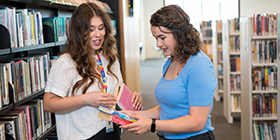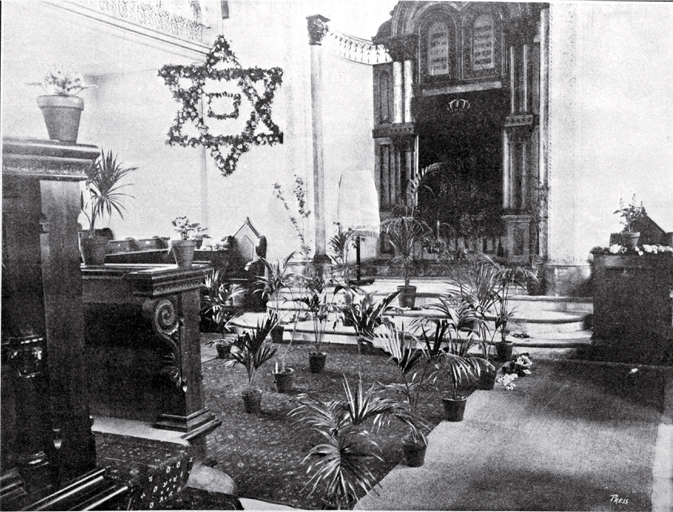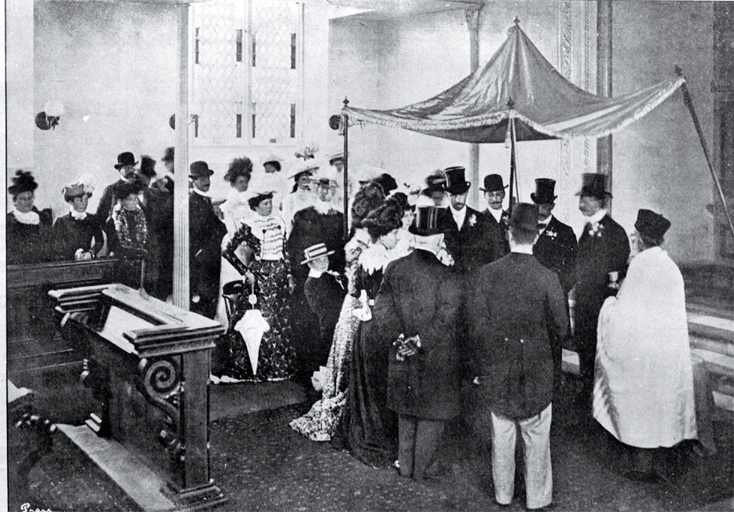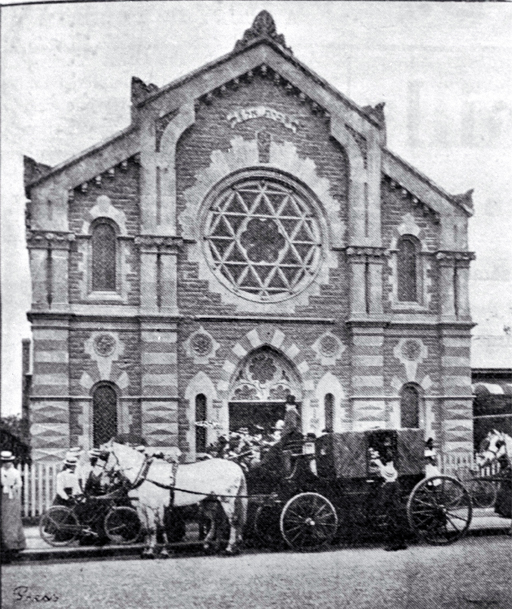A decision had been made.
It was time for Hyam Edward Nathan to give up his seat.
The members of Christchurch’s Jewish community, who arrived at the New Year service on 13 September 1882, knew to expect trouble when they saw that Nathan was already sitting in his self-appointed seat, B29.
The issue of Nathan assigning himself this seat had been raised at a recent meeting of the officers of the synagogue. Nathan, who had been present at the meeting, challenged the others to force him to give up his seat.
The seating of the synagogue, which opened only a year earlier, had been allocated by subscription, with the prime seats in sections A and B costing 3 shillings and 2 shillings a week. Seating in the C section was not allotted, due to the low number of applicants, and despite the free seating available, Nathan had taken it upon himself to sit in the lowest ranking seat of section B. Yet his free occupation of B29 had not gone unnoticed. Since 13 September was a holiday, it was important for the proper seat allocation to be followed, as B29 had been assigned to another member of the congregation.
Charles Louisson, the synagogue treasuer, took it upon himself to deal with the stubborn Nathan. After the ordinary services had finished, he approached Nathan and quietly pointed out that the seat had been reserved. Nathan was then ordered to vacate the seat by Maurice Harris, the synagogue president. Realising the matter would not be so easily settled, Constable Costin was summoned but upon arriving the policeman refused to become involved. Nathan then boldly stated he would not leave unless he was carried out. In response, Harris grabbed Nathan by the collar and with the assistance of Louisson, removed him from the seat and from the synagogue altogether.
Nathan would later take the matter to court, alleging that Harris and Louisson had assaulted him. However, the judge ruled in favour of the latter, showing that as they were officers of the synagogue, and since Nathan had no legal right to the seat, he had been in the wrong.
The Canterbury Hebrew Congregation
The founding a Jewish congregation in Christchurch, the Canterbury Hebrew Congregation, was first initiated in 1864, following a meeting held on 12 January at the High Street offices of auctioneer, Louis Edward Nathan (not to be confused with Hyam). Attending was Hyam Marks, Maurice Harris, E. Phillips, Marcus Sandstein, David Davis, Henry Moss, and S.M. Solomon. Gifted a plot of land on Gloucester Street by the government, the congregation built its first synagogue in 1864. To ensure the orthodoxy of their practice, traditional ritual items were sourced from various locations including a shofar (horn), ketubah (prenuptial agreement), and a mezuzah (prayers affixed to a door) from Melbourne, a Sefer Torah (scroll of Jewish law) from London, a lulav (enclosed date palm fronds) and matzah (unleavened bread) from Sydney, and an ethrog (citrus fruit) from the Holy Land.
While there were around thirty five prominent Jewish families in Christchurch at this time, many would soon depart for the West Coast to open businesses on the goldfields.
With the conclusion of the gold rush in 1870, many of these families returned to Christchurch. While majority of the early Jewish settlers in Christchurch were English Jews or Jews from Europe, they would soon appoint Isaac Zachariah, a Sephardic Jew from Baghdad, as their rabbi. Trained in Jerusalem, Zachariah had also served the Sassoon family in Bombay, India as a shohet (ritual butcher). After his time in India, he settled in Ballarat, Australia, before relocating to the Hokitika goldfields.
Due to his eclectic background, Zachariah could speak not only Hebrew but Arabic, Hindi, and forms of Aramaic. He was often called upon to translate at court trials involving individuals who spoke the languages in which he was fluent. Despite adhering firmly to his own customs and traditional forms of dress, Zachariah was tolerant of other faiths, and often engaged with members of the Anglican community. He also oversaw the establishment of the Christchurch branch of the Anglo-Jewish Association, an organisation dedicated to promoting the rights of Jewish people in regions outside of the British Empire.
Although a traditionalist, Zachariah possessed a rebellious streak, and often clashed with the congregation’s presiding committee. He was known for disregarding their orders, and in one case, he pre-emptively foiled their plans to export frozen kosher meat by writing to the Chief Rabbi in England to receive confirmation that frozen meat could not be considered kosher.
Beth El Synagogue
It was during Zachariah’s tenure that the new synagogue, Beth El, was built to replace the original wooden synagogue. Designed by Thomas Stoddart Lambert, the foundation stone was laid on 8 February 1881, whereupon it was sprinkled with corn, wine, oil and herbs. The synagogue was officially consecrated on 15 November 1881. Presided over by Zachariah, the ceremony was also attended by Anglican officials, some of whom had learned Hebrew from Zachariah.
The committee’s relationship with Zachariah deteriorated until he was eventually forced to resign. In 1889 he was replaced by Adolf Treitel Chodowski. Originally from Posen in Prussia, Chodowski had studied in Berlin before being admitted to the Jews’ College in London. Despite his popularity, the congregation could not afford to maintain his salary and he was forced to take up another position in Brisbane in 1894. The committee’s inability to provide a professional rabbi in the years that followed the departure of Chodowski eventually led them to allow Zachariah to return to the position. He would continue to serve the Jewish community in Christchurch until his death in 1906. He was buried in the Jewish section of Linwood Cemetery.
The Beth El synagogue would remain an iconic feature of Gloucester Street until it was demolished in 1987. In the following year a new synagogue was consecrated at 406 Durham Street. Although it suffered damage in the Canterbury earthquakes, it was repaired and reopened in 2013, where it continues to offer services every Shabbat.
Find out more
- Article on Hyam Edward Nathan
- Learn more about the Rosh Hashanah (Jewish New Year) and the Jewish calendar in Credo Reference.
- The Canterbury Hebrew Congregation.
- Read The History of the Jews in New Zealand.
- Read The First One-hundred Years of the Canterbury Hebrew Congregation







Add a comment to: Beth El Synagogue and the Canterbury Hebrew Congregation